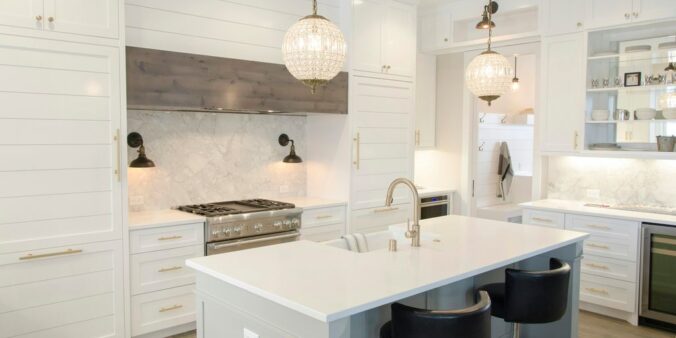Want to make the most of your camping experience by treating mealtime as a highlight rather than a chore? Here are our tips for creating a top-notch camp kitchen, including what gear to stock, how to prep before a trip, how to set up at camp, and tips to step up your outdoor cooking game.
Key Takeaways
- Gather essential cooking equipment, utensils, and storage solutions to ensure a well-stocked camp kitchen.
- Select the perfect spot for your camp kitchen and organize your cooking area for efficiency and safety.
- Equip your camp kitchen with essential tools such as cooking appliances, food prep essentials, and cleaning supplies.
- Plan your meals ahead of time, prep ingredients at home, and store food safely to simplify camp cooking.
- Optimize your camp cook station by using camp tables effectively and creating a functional layout to enhance your cooking experience.
Gathering Your Camp Kitchen Gear

When it comes to camping, having the right gear can make all the difference. A well-prepared camp kitchen can turn mealtime into a highlight rather than a chore. Here are some tips to help you gather the essential camping gear for your next outdoor adventure.
Must-Have Cooking Equipment
To create a top-notch camp kitchen, you’ll need some must-have cooking equipment. Consider packing the following items:
- Camping stove
- Portable grill
- Cookware (pots, pans, etc.)
- Instant read thermometer
- Oven mitts/pot holders
- Cooler(s)
- Water jugs
- Coffee/tea maker
- Kettle
Choosing the Right Utensils
Selecting the right utensils is crucial for any camp kitchen. Make sure to include:
- Spatula
- Tongs
- Spoons
- Forks
- Knives
- Cutting boards
- Plates/bowls/cups (preferably non-breakable and/or collapsible)
Storage Solutions
Effective storage solutions can help keep your camp kitchen organized and efficient. Here are some ideas:
- Foldable table/cook station
- Tupperware (for leftovers)
- Aluminum foil
- Resealable bags
A fully stocked camp kitchen will offer infinite options come mealtime, making your camping life much more enjoyable.
By gathering the right camping gear, you can ensure a safe and enjoyable camping trip for all campers.
Setting Up Your Camp Kitchen

Selecting the Perfect Spot
Choosing the right location for your camp kitchen is crucial. Look for a flat, shaded area away from your sleeping tents. This helps keep food smells from attracting wildlife to your sleeping area. Ensure the spot is close to your water source but not too close to avoid contamination. A well-chosen spot can make your cooking experience much more enjoyable.
Organizing Your Cooking Area
Once you’ve selected the perfect spot, it’s time to get organized. Set up a camp table or kitchen organizer unit to keep your cooking gear and ingredients in order. Use resealable plastic bags for storing small items and keeping them dry. Having a designated place for everything will make cooking and cleaning up much easier.
Safety Tips
Safety should always be a priority in your camp kitchen. Keep a bucket of water or a fire extinguisher nearby in case of emergencies. Make sure your cooking area is well-ventilated to avoid the buildup of harmful fumes. Always store food securely to prevent attracting wildlife. Following these safety tips will help ensure a safe and enjoyable cooking experience.
Remember, a well-organized and safe camp kitchen can make your outdoor cooking experience a highlight of your trip.
Essential Camp Kitchen Tools

When setting up your camp kitchen, having the right tools can make all the difference. A well-equipped camp kitchen ensures you can prepare meals efficiently and enjoy your outdoor cooking experience to the fullest.
Meal Planning for Camp Cooking

Meal planning for camp cooking can be a fun and rewarding experience. Preparing meals ahead of time not only saves you time at the campsite but also ensures you have everything you need for delicious outdoor dining.
Easy and Delicious Recipes
When planning your camp meals, consider recipes that are simple yet flavorful. One-pot meals, foil packet dinners, and pre-marinated meats are excellent choices. These options minimize the need for multiple cooking tools and make cleanup easier.
Prepping Ingredients at Home
My number one tip is to prepare as much at home as you can. Cut and wash your fruits and veggies ahead of time. Assemble or marinate meals utilizing large storage containers. This not only saves time but also reduces the amount of waste you need to manage at the campsite.
Storing Food Safely
Proper food storage is crucial when camping. Use coolers with ice packs to keep perishable items fresh. Store dry goods in airtight containers to prevent moisture and pests. Label each container with the contents and the date to keep track of your supplies.
A well-organized camp kitchen makes meal prep and cooking a breeze, allowing you to enjoy more time exploring and less time worrying about food logistics.
Optimizing Your Camp Cook Station
Using Camp Tables Effectively
Getting the tools to create optimized camping kitchens will make your trip overall more enjoyable. For example, using the right camp tables and creating an optimized cook station will set you up for success. A well-organized camp table can be the heart of your camp kitchen, providing a stable surface for food prep, cooking, and even dining. Consider tables with adjustable legs for uneven ground and built-in storage options to keep your essentials within reach.
Creating a Functional Layout
Cooking while camping can be a fun experience for everyone, but there are some key components to remember as you build your setup and collect the gear required for all of your ultimate camp kitchen needs. Arrange your cooking area in a way that maximizes efficiency and minimizes movement. Keep your stove, prep area, and cleaning station close together to streamline the cooking process. Think about the workflow: where will you chop vegetables, cook, and wash dishes? A functional layout can make all the difference.
Enhancing Your Cooking Experience
The focus here is on setting up a great camp kitchen, but what good is a well-stocked, perfectly organized grub hub if you’re not actually using it to whip up tasty meals? Get creative with your setup to enhance your cooking experience. Bring along some extra comforts like a portable sink, a spice rack, or even a small foldable shelf to expand your workspace. Seek inspiration from other campers and don’t be afraid to try new things to make your camp kitchen truly your own.
A well-thought-out camp cook station can transform your outdoor cooking from a chore into a delightful part of your camping adventure.
Staying Organized in Your Camp Kitchen
Staying organized in your camp kitchen is crucial for a smooth and enjoyable cooking experience. Nothing is easier than cooking in a kitchen where you can find all of your utensils quickly when needed. Here are some tips to help you stay organized and make your camp cooking more efficient.
Packing Tips
- Create a camp kitchen checklist and consult it before packing.
- Use storage bins, crates, or totes labeled with the items they contain.
- Pre-chop meats and vegetables, and store ingredients in reusable food storage containers labeled with the contents.
Keeping Track of Supplies
Keeping your various cookware, dishware, and camping pantry foodstuffs organized can be one of the biggest challenges. Taking a moment to get set up with a good system can really elevate your entire camping experience.
Maintaining Cleanliness
Inside the camp kitchen essentials tote(s), make sure to keep everything organized in bags and sections to keep things easier to find. All your eating utensils and straws in one bag, cooking utensils in another bag, pots and pans stacked on one side of the tote, and the cutting board and skillet against one of the long walls of the tote.
Let someone else set up the tents and get the campfire going—it’s time to cook!
Advanced Camp Cooking Tips
Cooking Over a Campfire
Cooking over a campfire is an essential skill for any outdoor enthusiast. Mastering this technique can elevate your camping meals from basic to gourmet. Start by building a stable fire and letting it burn down to hot coals. Use a grill grate or cast-iron skillet for the best results. Remember, patience is key—let the food cook slowly to absorb the smoky flavors.
Using a Portable Grill
A portable grill can be a game-changer for your camp cooking experience. These grills are compact, easy to set up, and offer a consistent cooking surface. Whether you’re grilling burgers, veggies, or even fish, a portable grill provides versatility and convenience. Don’t forget to bring extra fuel and a lighter for hassle-free cooking.
Making Gourmet Meals Outdoors
Who says you can’t enjoy gourmet meals while camping? With a bit of planning and the right ingredients, you can create dishes that rival your favorite restaurant. Consider marinating meats at home and packing them in sealed bags. Bring along fresh herbs and spices to enhance the flavors. And always have a few camp hacks up your sleeve, like using aluminum foil for easy cleanup or a Dutch oven for versatile cooking.
When you’re camping, things are a lot slower, and you can really enjoy spending time outdoors and cooking a delicious meal.
For more camp tips and tricks, keep experimenting and don’t be afraid to try new recipes. Happy cooking!
Elevate your outdoor culinary skills with our Advanced Camp Cooking Tips! Discover innovative techniques and recipes that will transform your camping meals into gourmet experiences. For more expert advice and detailed guides, visit our website and take your camp cooking to the next level.
Conclusion
Setting up a camp kitchen can transform your outdoor experience, making mealtime a highlight rather than a chore. By gathering the right gear, staying organized, and optimizing your setup, you can enjoy delicious meals in the great outdoors. Remember, you don’t need to have everything at once; you can build your camp kitchen over time. Keep things clean, functional, and well-organized to make cooking and meal prep a breeze. With these tips and essentials, you’re well on your way to creating memorable and enjoyable camping adventures. Happy camping and bon appétit!
Frequently Asked Questions
What are the essential items for a camp kitchen?
Essential items for a camp kitchen include a camping stove, portable grill, cookware, utensils, cutting boards, plates, bowls, cups, cooler(s), water jugs, and a coffee/tea maker. Additionally, having storage solutions like Tupperware, resealable bags, and a foldable table or cook station is crucial.
How do I choose the right spot to set up my camp kitchen?
Select a flat, stable area away from your sleeping tents and any potential hazards like low-hanging branches. Ensure the spot is well-ventilated, especially if you’re using a camping stove or grill, and close to a water source if possible.
What are some tips for organizing my camp kitchen?
Keep frequently used items within easy reach and group similar items together. Use storage bins or bags to keep utensils, cookware, and ingredients organized. Label containers and create a checklist to keep track of supplies.
How can I ensure safety while cooking at a campsite?
Always keep a bucket of water or a fire extinguisher nearby. Make sure your cooking area is well-ventilated and never leave a fire or stove unattended. Keep flammable materials away from open flames and ensure all cooking equipment is stable and secure.
What are some easy and delicious camp cooking recipes?
Some easy and delicious camp cooking recipes include foil packet meals, one-pot pasta dishes, grilled vegetables, and campfire chili. Prepping ingredients at home can save time and make cooking at the campsite more enjoyable.
How do I maintain cleanliness in my camp kitchen?
Clean as you go to avoid a buildup of dirty dishes and utensils. Use biodegradable soap and a designated wash station. Store food properly to avoid attracting wildlife and dispose of waste in designated areas.


Leave a Reply